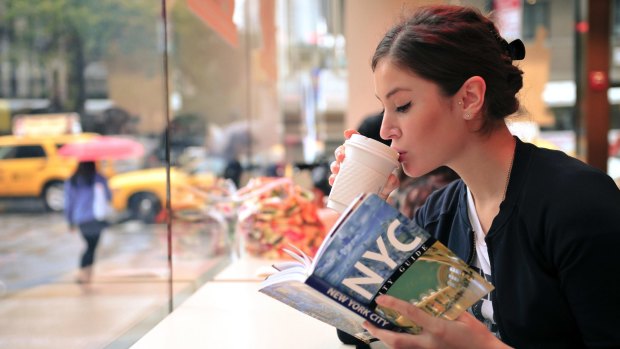This was published 8 years ago
Time Out culls city guidebooks: Is time up for printed guidebooks?

Books are portable, durable, love us to scribble in them and fit snuggly in hand luggage. Credit: iStock
In late December I read that Time Out had announced 40 redundancies. Nothing new there. The publishing company founded in 1968 by Tony Elliott has been shedding editorial staff (including, in 2012, me) as it has evolved into a global ticketing agency, the focus aggressively on web-based content. It also has a knack of issuing redundancies during the festive period.
This month I heard via the social media grapevine that the shrinkage included the culling of Time Out's acclaimed travel guides. Having contributed to more than a dozen of these and edited several others, I share the former staff's lamentations that a great brand has disappeared from travellers' bookshelves.
Time Out's guides evolved out of its gritty, streetwise 1972 Book of London, which combined advice on avoiding tourist traps with tips on sexual health. New York and Paris were two early travel guides that garnered critical acclaim and solid sales – the 23rd edition of both appeared only last autumn, RRP £13.99 ($A30) – and the brand eventually branched out as far afield as Baku, São Paulo and Seoul.
For a time, Time Out provided a cool template for the way travel – and travel publishing – were evolving. Where Lonely Planet and Rough Guide aimed young and budget-conscious, and DK and Fodor played safe by targeting grey nomads, Time Out guides highlighted stylish independent hotels, innovative chefs, gay scenes and fringe venues and most contained leftfield features on local politics, fashion and the arts.
Competing publishers picked up on Time Out's trend-spotting. Nowadays, all except those marketed at old-school (mainly American) coach tourists or young gappers on shoestrings incorporate lifestyle insights and indigenous voices.
We're accustomed to convulsions in the world of travel guide publishing. BBC Worldwide's £80m ($A167m) write-down when selling off Lonely Planet was the most dramatic. Bookshops shove travel into tiny spaces these days. Everybody is, we are told, quite content online.
But are printed guides really over? No, not quite. Some stalwarts survive by knowing their audiences and by using digital platforms alongside print.
Rough Guide and Lonely Planet, the two biggest players in the independent/backpacker market, have migrated a lot of content online, and attract respectable traffic. Lonely Planet ranks 14th on the Alexa internet ranking, just below Airbnb. However, they face the dilemma of not giving too much away and risking losing book buyers. Their sites also offer rather similar user experiences, having converged on a style and layout that is mainstream and somewhat middle-market when compared to their original guidebooks.
Georgina Dee, publishing director at Rough Guides, remains upbeat: "It is tough to see longstanding competitors close up shop but there are obvious benefits for those of us still in the market. 2015 was an encouraging year in the UK with confidence in both travelling and in printed guides taking an upturn.
"The promise of digital destination guides has not really born out, much like the plateau in fiction ebooks that we've seen this year.
"Consumers want highly practical use from their travel digital companions rather than a facsimile of the printed version. For us, digital is the opportunity to supplement what our print guides can offer - sometimes the best 'technology' is ink on paper."
It's a fair point: wi-fi is not universally free and is unavailable in many far-flung rural areas; there's patchy 2G and no 3G across many parts of the UK.
Books are portable, durable, love us to scribble in them and fit snuggly in hand luggage. They sit on our living-room coffee tables, reminding us we're heading overseas soon, like airline tickets (also being phased out) used to. They don't need charging. They smell nice.
There have been innovations, too. The "Only In" guides to Budapest, Munich and Zurich, all written by Duncan Smith, stick to static information, ignoring the stuff we get on the net: hotels, bars, airport transfers, etiquette.
The Cityscapes (from Reaktion Books) and Cities of the Imagination (Signal Books) series do something similar, privileging flowing prose written by specialists and academics over "how to" advice.
"Research show that people don't just want crowdsourced information, algorithmically driven towards more and more questions," says Simon Das, a lecturer at the London College of Communication."They want answers and authoritative voices too."
Expert voices drive Telegraph Travel's publication of around 150 extensive digital destination guides and apps, which stand out in a burgeoning universe of online sources, from a zillion home-spun blogs to the rants and ratings of Yelp and TripAdvisor.
The latters' reliance on user-generated information is the current global template. It's far, far cheaper than producing guides. Though publishers pay guide writers day-rates somewhere below those of waiters at, say, pizza restaurants, the costs of editing, design, printing, photography, distribution quickly mount up.
Time Out will retain a presence in travel through its local print and online magazines in places like Accra, Chicago and Kuala Lumpur. But its printed city guides were produced by London-based editors and often two-dozen or more locally based authors. That kind of expertise is expensive. Genuinely curious, thorough researchers who can also write and punctilious copy-editors are rare species.
Their era may be over. I suspect, though, that a canny publisher somewhere – perhaps in a less digitally-dazed city than London – will wonder if there isn't still a market for savvy, honest, balanced, sharply written, witty printed guides. I'd pay £14 – less than two pints of lager in Stockholm, according to Time Out – for them.
The Telegraph, London
Sign up for the Traveller newsletter
The latest travel news, tips and inspiration delivered to your inbox. Sign up now.